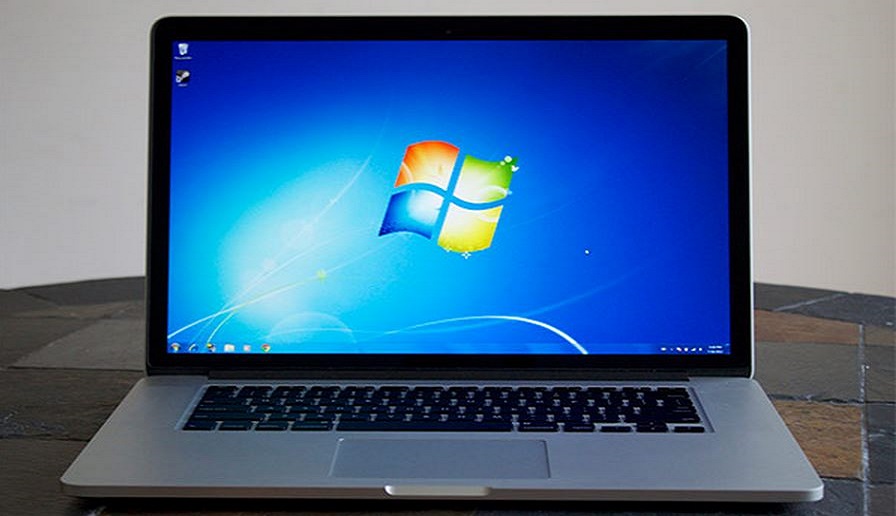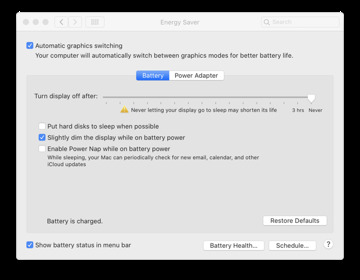Regular breaks — for your and for your battery. Just like you, your MacBook battery needs to take breaks throughout the work day. To look after your own body, I recommend Awareness, a free app. These apps let you keep an eye on battery health and improve battery life. The last thing you want is for your MacBook's battery to die when you need it most. While Mac laptops do offer solid battery life compared to many competitors, even the best batteries decline with age. What's new in this version.V 2.0.20.0. Bug fixed and improvements.V 2.0.19.0. Bug fixed and improvements.V 2.0.17.0. Bug fixed and improvements Update status of battery every minute instead of 15 minutes for minimized application.V 2.0.16.0. Bug-fix: Settings screen not open for some users.V 2.0.15.0. Added help to find language option in system.
- Be sure to check out the 'Tips' section within the app to learn a host of useful ways to improve the life of your MacBook's battery. FROM CNET Upgrade to Windows 10 for free right now.
- Best Apple Watch apps to keep you healthy. You already know your Apple Watch can do a lot. From monitoring your heart rate to sending 'take a break' reminders, Apple Watch is arguably one of the.
- The battery on my mid 2009 MBP is on its way out. I found out recently that Apple now does not service batteries for mid 2009 MBP's as they are vintage. I was very disappointed in Apple after hearing this. My question is what is the best third party battery replacement my laptop? I've read reviews from Anker, Lizone, Key Power, and GreenBox.

Apple’s been in the courtroom for several years now, after the company was found to be slowing down older iPhones without the consent of the owners. The company’s reasoning? The health of the batteries inside those iPhones had degraded to a point where running at full speed could trigger shutdowns or other issues.
That series of lawsuits has also led to Apple adding a very useful tool into its products, including the Battery Health feature.
The feature lets you see how well your battery is faring under your usage, and also tells you if you can do things to improve the battery’s health, or if you need to replace it. That same tool is also coming to the Apple Watch, and macOS is getting some new stats pages for a more complete picture of your battery use, as well.
Here’s how to check the battery health of your iPhone, iPad, Apple Watch, and MacBook
It’s pretty simple to check the new inbuilt tools that Apple added, so you can keep an eye on your not-user-replaceable battery.
iPhone or iPad:
- Open the Settings app
- Scroll down to Battery and tap
- Tap on Battery Health
- You’ll see percentages detailing your battery’s health, plus suggestions if your battery is less than optimal Image: KnowTechie
This last screen will also tell you if your battery has degraded to the level of needing a replacement. Just know that’ll cost around $80 if so.
Apple Watch:
You’ll need to be updated to WatchOS 7 to be able to check the battery health on your Apple Watch. So, until the public beta arrives, you’ll need to be using a developer account to access this currently. If you are, here’s how to check:

- Open the Settings app
- Scroll down until you see Battery, then tap on it
- Tap Battery Health
That’s it, you’ll now see a percentage indicating how healthy your battery is, and any advice you may need on how to improve it.
MacBook:
Apple added a Battery Health feature to macOS back in April, but macOS Big Sur (the next major update) brings even more battery tools. You’ll be able to see exactly which apps are draining your battery, both as a daily rundown or over the last ten days.
- Open System Preferences from the Apple logo at the top left of your screen
- Click on Battery
You’ll now see graphs of your Mac’s energy usage on the Usage History tab, along with a graph of Screen On Time, so you can match the two together. You can also check the battery health of your MacBook by going to System Preferences > Power Saver > Battery Health.
That’ll give you the health status, and an option about disabling Battery Health Management, which automatically adjusts performance and the maximum charge of your MacBook’s battery depending on your usage habits. It’s pretty much the same system that’s in iOS, so it will be interesting to see how well it works when it hits my work laptop in the fall.
Optimized battery charging
Image: KnowTechie
While you were checking out your battery health on your iPhone, you probably saw a toggle for Optimized Battery Charging. This handy setting learns your charging routine, then instead of fully charging your device, it’ll charge to 80% until before you usually pick it off the charger, when it will finish charging to 100%. That puts less strain on your battery over time, hopefully resulting in a longer lifespan for your device.
Oh, and while we have you. If you had an iPhone 6, 6 Plus, 6S, or SE, or an iPhone 7 or 7 Plus that experienced slowdowns, go join the class action so you get some cash for your troubles.
What do you think? Plan on using these features to check on your iPhone’s battery health? Let us know down below in the comments or carry the discussion over to our Twitter or Facebook.
Editors’ Recommendations:
In this article, we'll look at common problems and 5 fixes for these MacBook and MacBook Pro battery problems.
Why is my Mac battery draining so fast?
There can be a number of reasons. For example, different browsers consume different amounts of battery power.
In some cases, a recent upgrade to a new macOS can be the cause and therefore a temporary problem. It either stops doing this in its own time, or a new macOS patch/upgrade is sent through and once downloaded the problem goes away. It is known to happen around the time of new releases and is an issue many Mac owners anticipate.
However, in other cases, the issue is less widespread and more localized. We cover five of the most common problems and fixes for Mac users, in particular MacBook owners who have suffered from a fast draining battery.
5 solutions for Mac battery problems
1. Check and change Battery Settings
In the top menu, where the battery appears, it’s always useful to switch usage to a statistics setting, so that you can clearly see how fast it's draining.
If you click on the battery, it will show which apps are using the most amount of power.
- From here, click on Open Energy Saver Preferences
- Within this you’ve got the option to put the hard disks to sleep and dim the display when a Mac is not connected to power.
2. Switch on Energy Saver
Always useful when trying to conserve battery power on any device, and it could be a lifesaver if you happen to be out without a power cord or plug.
- From the Apple menu;
- Go to System Preferences > Energy Saver
- Now click on the Battery tab
- A slider should be on this screen: Switch Power Nap off, while sliding the scale along to ensure the screen goes dark after a reasonable amount of time when not being used, which should reduce battery drainage.
3. Find out what is using energy
When investigating a fast draining battery, it’s always useful to know what is using energy in the first place. To find out, follow these steps:
- Go to Applications;
- Click on Utilities > Activity Monitor;
- Activity Monitor will show what is taking up CPU and GPU;
- Giving you the ability to close anything that is clearly taking up too much battery power.
4. Identify background apps
Best Battery App Iphone
Behind the scenes, most Macs can run dozens of apps without us realizing it. Some of these could be running because we forgot about them. Others open during the startup sequence. And others, without us knowing it, could be malware or ransomware, or other viruses, either designed to steal data or steal processing power to mine cryptocurrency or even run remote DDoS attacks.
Now, clearly that sort of thing isn’t ideal and you won’t want apps running that drain power, steal data, or that use your Mac for something you aren't even aware. To solve these potential battery draining problems, we recommend taking the following steps:
- Download CleanMyMac X (for free, here)
- Click on Uninstaller
- It will run a scan of every app on your system: Either click to rest or safely uninstall everything you don't need or aren't aware of.
Best Mac Battery Apps
Also, click the Optimization tab in CleanMyMac. You’ll find the tool called Launch Agents.
It displays tiny background applications otherwise non visible to a user. This very often gets exploited by advertising scripts — a sure way to drain your battery power.
As you can see, these items can be easily switched off using the Disable button.
5. Adjust screen brightness
Best Mac Battery App Windows 10
The brightest lightbulbs consume more energy, same is true for your screen's lighting. In your Preferences, look up Displays settings and do a couple of tune-ups there. Make sure to tick 'Automatically adjust brightness' checkbox.
6. Clean up your Mac
Macs battery benefits from various forms of cleaning. Why? Because the cluttered hard drive uses more CPU resources. The more strain on CPU, the more it affects and eventually wears off your battery. There are dozens of pretty good tools to remove hidden junk from Mac but my personal favorite is CleanMyMac X. It's so enjoyable to use even for such a trivial operation as deleting junk files.
- Download CleanMyMac X — here 's a link to a free edition
- Click on the System Junk tab
As you can see, I was able to remove 18.9 GB worth of useless files: caches, broken downloads, localizations, etc.
Sit back and know that with a tidy Mac, with it free from all of the clutter of years of use — and a monitoring system in place to look after it — your battery should be operating at optimum levels again.